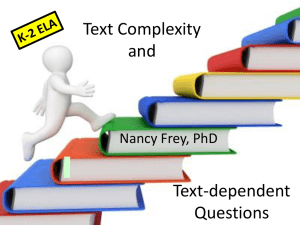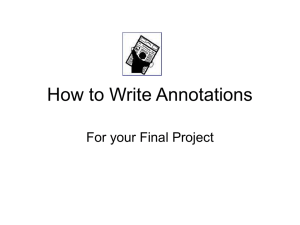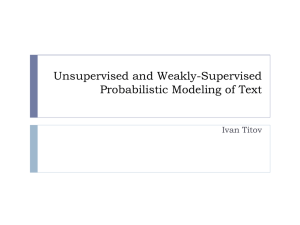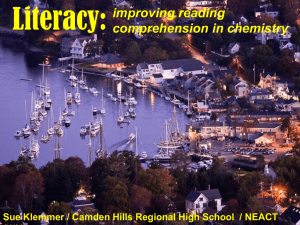Lecture 09
advertisement
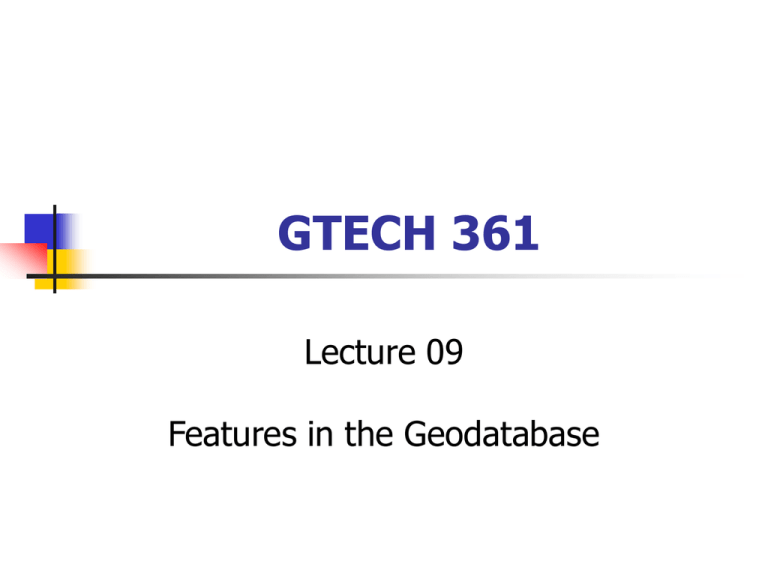
GTECH 361 Lecture 09 Features in the Geodatabase Today’s Contents Creating simple features Editing coincident features Creating annotation features Creating Simple Features Features class geometry Splitting features Splitting lines Splitting polygons Combining features Multi-part features Merge Union Intersect Auto-complete polygons Feature Class Geometry Multi-part Features Splitting Lines Splitting Polygons Merge Union Intersect Auto-complete Polygons Editing Coincident Features Creating map topology Editing nodes and edges Preventing editing errors Moving an edge or node Reshaping an edge Modifying an edge Example: implementing a geodatabase Editing Errors Creating topology to prevent editing errors Adjacency = Common Border The primary purpose of a topology is to define spatial relationships between features Preserving Coincidence Preserving Connectivity Common Topology Elements Both edge and node are treated as single elements Multiple copies of them stored in the geodatabase are moved as if they were one Storage of Shared Feature Parts in the Geodatabase Editing Nodes and Edges Moving an edge or node The edge is rubber-banded Modifying an edge Reshaping an edge Creating Annotation Features What are annotation feature classes What are annotation classes Types of geodatabase annotations Standard Feature-linked* Dimensioning* Geodatabase Annotation Functionality Arc View Create and edit standard annotation. View feature-linked and dimension annotation ArcEditor ArcInfo Create and edit standard, featurelinked, and dimension annotation. Ability to create multiple annotation classes for an annotation feature class Annotation Feature Classes Are like other geodatabase feature classes; they have Attributes that define how text is displayed Spatial reference Can be added as a layer to ArcMap Can be created from labels, or are Created in ArcCatalog from scratch Annotation Feature Classes Annotation Classes All annotation feature classes have at least one annotation class Text symbology Alignment With ArcEditor or ArcInfo Multiple annotation classes within one annotation feature class to Specify different annotation display properties for different types of features Annotation Types Standard annotation Feature-linked annotation Dimension annotation Standard Annotation Like labels with georeference Feature-linked Dimensioning Summary of Today A geodatabase feature class can store point, multipoint, line, or polygon features. Multipart features and features with true curves are also supported You can create new features by digitizing or by using ArcMap editing tools such as Merge and Union. Features can also be created as the output from geoprocessing operations, such as clip When editing features, you can maintain their spatial relationships by creating a map topology. Once you've created a map topology, you can use ArcMap's topology editing tools to maintain coincidence between parts of features within a single feature class or among multiple feature classes There are three types of geodatabase annotation: standard, featurelinked, and dimension annotation. All annotation feature classes contain at least one annotation class The GIS Process D ecision R u les N on -sp a tia l D a ta T ra n sform a tion of S p a tia l D a ta - E n h a n cem en t of In form a tion C on ten t - C h a n g e in A m ou n t of S p a tia l D a ta - V a lu e A d d ed P roS p a tia l O bject s d u cts G IS D a ta C ollection A n d O rg a n iz a tion S p a tia l D a ta G eog ra p h ic H a n d lin g a n d A n a lysis & M a n ip u la tion Q u a n tita tive M od elin g P red iction and P rojection for D ecision M akin g G eog ra p h ic T h eory The GIS Process 1. Defining the problem/question and information products 2. Estimating costs and benefits (establishing initial justification) 3. Inferring GIS functionality requirements and processes 4. Establishing quality control parameters and procedures 5. Establishing resource allocations and timetable 6. Carrying out GIS procedures 7. Evaluation 8. Report details regarding the management of project, data sources, processes involved, outputs, outcomes, etc. 9. Archive digital information representing data and analysis Typical GIS capabilities Raster GIS Local operations Recoding Overlaying layers Operations on local neighborhoods Operations on extended neighborhoods Operations on zones Vector GIS Reclassify, dissolve, merge Topological analysis Buffering Measurements Operations on surfaces Network analysis Data model-dependent classification after Goodchild points: techniques used to analyze an undifferentiated set of points, e.g. point pattern analysis; spatial objects with attributes: techniques that analyze an attribute matrix, and reduce space to a square matrix of spatial relationships between pairs of objects, e.g. measures of adjacency or proximity; networks of links and nodes: a range of techniques for analyzing networks in transportation and hydrology, based on attributes of network links and nodes; spatial interaction models: models of the interaction between pairs of objects, based on an analysis of the characteristics of origin objects, destination objects, and the spatial separation between them; raster techniques: methods of analysis based on the representation of continuous layers as rasters of cells, and supported by the so-called raster GISs. OGIS Reference Model Solicited Categorization of GIS Operations Visualize / Show Encode Compare (partial) Select Substitute Derive Correct Evaluate Find Monitor Create Combine Allocate Determine Aggregate/Summarize Goals or "meta tasks" as they are used by expert GIS users INVENTORY Locates, counts, or records items w/o having any implications concerning desirability RESOURCE Desirable, useful, or limited phenomenon to be conserved or protected RESTRICTION Constraint that limits the availability, desirability, or location of a target or resource REFERENCE Provides spatial control or anchor for locating features in other roles PREDICTION Attribute values correlated with the presence of target phenomena THREAT Phenomena that may injure, destroy, or have other negative effects TARGET Desired or valued phenomenon to be found or located SOLUTION Composite result of analysis, embodies the application of analysis criteria Confirmed Image Schemata Spatial Relations: coincide, overlaps, near/far, adjacent, separates/connects, subdivided, contain, above/below (concerning the model rather than real world phenomena) Logical Relations: part-of/consists-of, is-a, has-a, same/different Procedural Relations: causes/caused-by, stands-for, abstracted-to Operations to be hidden from the user A first compilation of user-oriented GIS operations


